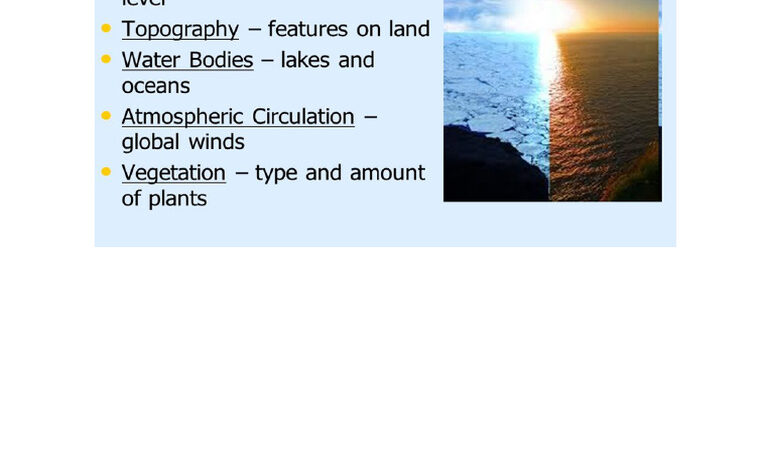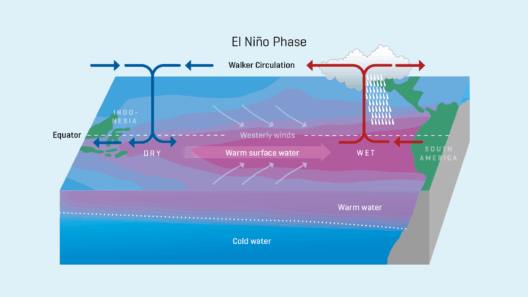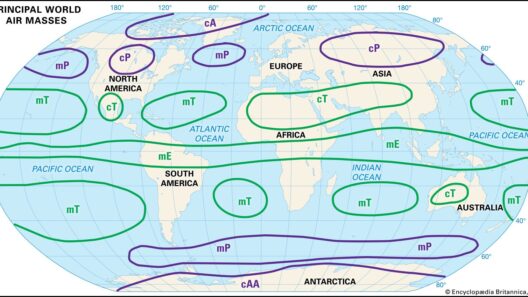The intricate tapestry of climate is woven from various threads, and understanding the principal factors that influence it is crucial for grasping the broader implications for our planet. The four main factors that significantly affect climate are solar radiation, atmospheric composition, oceanic currents, and topography. Each of these elements plays a pivotal role in shaping weather patterns, ecosystems, and ultimately, the future of the biosphere.
The first factor, solar radiation, is fundamental to the climate system. Solar energy emanates from the sun and is the primary source of warmth for Earth. The amount of solar radiation received by a given location varies based on several factors, including the angle of the sun, atmospheric conditions, and the planet’s distance from the sun. This variation is most pronounced between the equator and the poles, leading to significant climatic differences. For instance, regions near the equator receive more direct sunlight throughout the year, resulting in tropical climates characterized by consistent warmth and humidity. In contrast, polar regions are bathed in less sunlight, leading to colder temperatures and unique ecosystems adapted to extreme conditions.
The intensity and angle of solar radiation also undergo seasonal changes. During summer months, areas tilted toward the sun experience heightened warmth and extended daylight hours, while winter months invoke the opposite effect. This cyclical pattern influences not only temperature and daylight but also biological rhythms within ecosystems, including seasonal migrations and breeding cycles among wildlife.
The second influential factor is atmospheric composition. The air wrapping our planet is not merely a bland mix of gases; it is a dynamic concoction that influences climate through its interaction with solar energy. The most important constituents of Earth’s atmosphere include nitrogen, oxygen, and trace greenhouse gases such as carbon dioxide (CO2) and methane (CH4). Greenhouse gases are particularly significant, as they trap heat within the atmosphere, creating what is commonly known as the greenhouse effect. Without this natural phenomenon, Earth would be inhospitably cold.
However, human activities, particularly industrialization and deforestation, have dramatically increased the concentration of greenhouse gases, enhancing the greenhouse effect and leading to global warming. This rise in temperature contributes to melting ice caps, rising sea levels, and more frequent and severe weather events. Understanding the delicate balance of atmospheric composition is vital for addressing climate change and mitigating its impacts on global ecosystems.
Moving beyond the atmosphere, the third factor that significantly affects climate is oceanic currents. Oceans cover more than seventy percent of the planet’s surface and play an indispensable role in regulating climate. Ocean currents, driven by wind patterns, the Earth’s rotation, and differences in temperature and salinity, act like a conveyor belt, redistributing heat across the globe. For instance, the Gulf Stream carries warm water from the tropics to the North Atlantic, affecting the climate of Northwestern Europe, contributing to milder winters compared to other regions at similar latitudes.
These currents influence not only regional climates but also global weather patterns. El Niño and La Niña, for example, are phenomena driven by changes in ocean temperatures in the Pacific Ocean, with profound impacts ranging from increased rainfall in one area to droughts in another. As such, the health of our oceans and the intricate relationships within ocean ecosystems are crucial in the discourse around climate dynamics and global weather variability.
The final factor, topography, refers to the physical features of the Earth’s surface, such as mountains, valleys, and plains. The elevation and layout of land significantly influence local climates and weather patterns. Mountains can create rain shadows, where one side experiences heavy precipitation while the opposite side remains arid. Additionally, elevation plays a critical role in temperature variations; as altitude increases, temperatures tend to decrease. This phenomenon results in diverse habitats within relatively close proximity, highlighting the intricate relationship between topography and climate.
Furthermore, regions with distinct topographical features often harbor unique microclimates. These localized climatic variations can support specialized flora and fauna adapted to specific environmental conditions, emphasizing the necessity of topographical factors in sustaining biodiversity. Human development in these diverse landscapes also necessitates consideration of climatic effects, as changes in land use can disrupt established climatic patterns and threaten local ecosystems.
In conclusion, the four main factors that affect climate—solar radiation, atmospheric composition, oceanic currents, and topography—interact in complex ways to create the climatic conditions we experience. An understanding of these elements is essential for anticipating future climatic changes, developing policies to mitigate climate impacts, and fostering sustainable practices to protect the environment. As we address the challenge of climate change, recognizing these foundational factors is imperative for informed decision-making and fostering resilience in a changing world.








